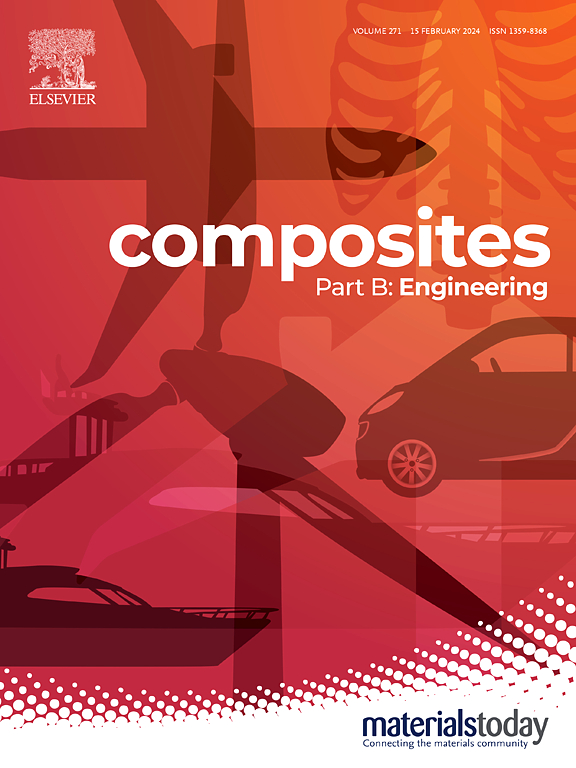Influence of surface modification on the interfacial properties of ultra-thin steel foils and CFRP co-curing without adhesive film:A comparative study of different techniques
IF 12.7
1区 材料科学
Q1 ENGINEERING, MULTIDISCIPLINARY
引用次数: 0
Abstract
Ultra-thin stainless-steel foil, renowned for its high strength, corrosion resistance, and excellent formability, shows significant promise in fiber metal laminates. However, enhancing the interfacial adhesion between ultra-thin stainless-steel foil (less than 0.05 mm thick) and CFRP remains a technical challenge. Metal surface pretreatment is crucial for determining the bonding quality of steel/CFRP interfaces. In this study, cold spraying and laser scanning techniques were used to pretreat 30 μm thick ultra-thin stainless-steel foil. The effects of different treatment processes, both individually and in combination, on the physical and chemical states of foil surface were systematically characterized, and their impact on the interface bonding properties of steel/CFRP was analyzed. By progressively optimizing the metal surface modification process based on laser scanning treatment, significant improvements were achieved in active site density on the metal surface, resulting in a single lap shear strength of 30.07 MPa for co-cured steel/CFRP laminate without adhesive film. Compared to untreated samples, there was an impressive increase of 210.32 % in interfacial bond strength. This study presents a straightforward and environmentally friendly solution to enhance the interfacial performance between ultra-thin stainless-steel foil and CFRP laminates.
表面改性对超薄钢箔与CFRP共固化界面性能的影响:不同工艺的对比研究
超薄不锈钢箔以其高强度、耐腐蚀性和优异的成形性而闻名,在金属纤维层压板中显示出巨大的前景。然而,如何增强超薄不锈钢箔(厚度小于0.05 mm)与碳纤维增强塑料(CFRP)之间的界面附着力仍然是一个技术挑战。金属表面预处理是决定钢/碳纤维复合材料界面粘接质量的关键。本研究采用冷喷涂和激光扫描技术对30 μm厚的超薄不锈钢箔进行预处理。系统表征了不同处理工艺(单独处理和组合处理)对铝箔表面物理化学状态的影响,分析了不同处理工艺对钢/CFRP界面结合性能的影响。通过逐步优化基于激光扫描处理的金属表面改性工艺,金属表面活性位点密度显著提高,无胶膜共固化钢/CFRP复合材料单次抗剪强度达到30.07 MPa。与未经处理的样品相比,界面结合强度提高了210.32%。本研究提出了一种简单环保的解决方案,以提高超薄不锈钢箔和CFRP层压板之间的界面性能。
本文章由计算机程序翻译,如有差异,请以英文原文为准。
求助全文
约1分钟内获得全文
求助全文
来源期刊

Composites Part B: Engineering
工程技术-材料科学:复合
CiteScore
24.40
自引率
11.50%
发文量
784
审稿时长
21 days
期刊介绍:
Composites Part B: Engineering is a journal that publishes impactful research of high quality on composite materials. This research is supported by fundamental mechanics and materials science and engineering approaches. The targeted research can cover a wide range of length scales, ranging from nano to micro and meso, and even to the full product and structure level. The journal specifically focuses on engineering applications that involve high performance composites. These applications can range from low volume and high cost to high volume and low cost composite development.
The main goal of the journal is to provide a platform for the prompt publication of original and high quality research. The emphasis is on design, development, modeling, validation, and manufacturing of engineering details and concepts. The journal welcomes both basic research papers and proposals for review articles. Authors are encouraged to address challenges across various application areas. These areas include, but are not limited to, aerospace, automotive, and other surface transportation. The journal also covers energy-related applications, with a focus on renewable energy. Other application areas include infrastructure, off-shore and maritime projects, health care technology, and recreational products.
 求助内容:
求助内容: 应助结果提醒方式:
应助结果提醒方式:


